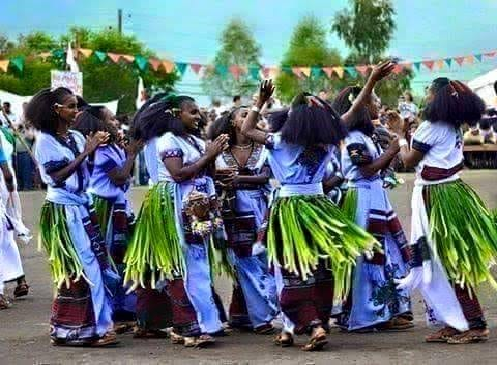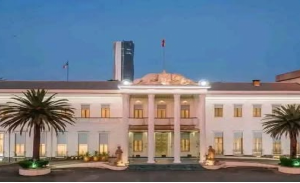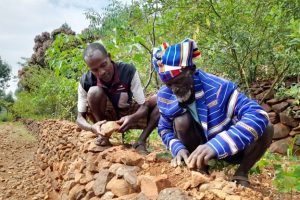
Ashenda, Shadey, Ashendiye, Solel is one of the festivals celebrated in the northern part of Ethiopia, in Amhara and Tigray states. The name of the festival, as documents indicate, comes from the “tall green grass”, Ashendeye, which is estimated to be around 80–90 centimeter with a minimum height; and girls put on around their waist during celebrating the holiday,.
According to sources, in the northern part of Ethiopia, divided in groups, primed girls eagerly look forward to this cultural play on the eve of the sunny season. Following the heavy rain of the summer season (Kiremet) the grasses profusely grow longer and longer. This grass has a great value for those girls waiting for the actual day of the Shadey, Ashendiye, Solel, Ashenda ceremonial event. They unplug these long grasses from their surrounding and make a miniskirt out of them. Doing so is not the girls’ final objective. Gathering in groups and going out into streets, they stage different traditional dances chanting heart titillating songs beating a special drum with their hands. This as well is not their ultimate goal. Rather they dream beyond the game, which facilitates good interactions with their peers. As they go out at their best, they lure the opposite sex, with peeled eyes who are alert to choose their best. In most cases the girls win suitors.
Shadey in Wag Hemira, Ashendiye in Lasta Lalibela, Solel in Raya, and commonly known as Ashenda in Tigray is a religious and cultural annual festival of women. The festival is celebrated starting from the mid-August up to the end of the month. Nowadays, this public festival has become the prominent cultural manifestation of residents of the locality. They mark the week-long holiday giving it special consideration as well as getting themselves ready ahead of time. The ceremonial occasion serves quite a role in cementing the relationship and ties of the society getting involved. Also, it helps to bequeath this intangible heritage to coming generations.
Ashenda, Shadey, Ashendiye, Solel is an all-embracing participatory public festival in Amhara and Tigray states when the rainy season is due to end. More often, it is played by females. But most of the time, males participate in the ceremony as admirers of the play and as bodyguards to the ladies. The fete has no age limit. Making a group of 5 up to 20, children also take part. The group criteria are based on friendship and neighborliness, among others.
After readying themselves and finalizing the required prerequisites needed for the ceremony, young girls and women convene and sing together revealing their happiness and gratitude’s to those that offers them gifts on their ways.
Various tourism experts witnessed that Ashenda, Shadey, Ashendiye and Solel rite is among the top street festivals in Ethiopia. It is one of the intangible cultural heritages celebrated annually at the end of the rainy season.
Tourism Expert and Consultant Abraham Chekol said that the annual celebration of Ashenda, Shadey, Ashendiye and, Solel is gaining a better attention among the public following the effective awareness to own cultural assets.
Currently, children are also actively participating in such celebrations. In doing so, the new generation is contributing its part to the restoration of ancient tangible and intangible heritages. In the past few years, there were some sorts of negligence to own cultural values following the growing influence of globalization. However, the successive public mobilization through the media and tourism experts motivates the society to develop and conserve festivals for tourism, he said.
He also highlighted the greater tourism potential such festivals have and their significant contributions in terms of creating massive job opportunities. The annual celebration of Ashenda, Shadey, Ashendiye, Solel lasts up to a week and enables tourist service providers to deliver improved touristic services, and gain considerable rewards.
Currently, this public festival becomes the prominent manifestation of the society in the area. They celebrate it giving cordial and special consideration as well as with preparation that takes a longer time. The ceremonial occasion is strengthening the relationship and ties of the society being involved in the festival; to keep the culture and hand over it to grandchildren and the future generations.
As to him, this cultural and religious festival contributes a lot in the manifestation of the society and plays role in strengthening the societal ties and mutual coordination beyond sharing cultural values.
The tourism expert also expressed that celebrating this age-old festival has a tremendous significance to the society. It boosts the mutual relationship of the community. It is playing a huge role in manifesting the socio-economic, cultural, political, psychological and other aspects of the community. Due to this it is gaining due attention year after year.
Accordingly, it is necessary to underpin those cultural festivals being celebrated worldwide and nationwide as they are one of the assets of the society owning that culture. This cultural ceremony’s role is fundamental to boost societal interaction and oneness under its umbrella. Eroding of the actual ceremonial process might erode the mutual pleasure that happen while convening together.
In sum, it needs to be alert to withstand the problem globalization poses on our culture and traditional assets. Everyone must engage in retrieving and keeping his/her own culture. Everyone else as much as owners of the heritages is duty bound and has a greater responsibility of preserving the traditional assets worthy of inheritance to the future generations.
The festival is one of the wonderful cultural ceremonies held in the northern part of Ethiopia. It has enormous cultural, economic and social significance. It serves to tighten societal ties. This festival is gaining adorableness as well as widespread recognition and popularity from time to time.
BY TEWODROS KASSA
THE ETHIOPIAN HERALD FRIDAY 25 AUGUST 2023





